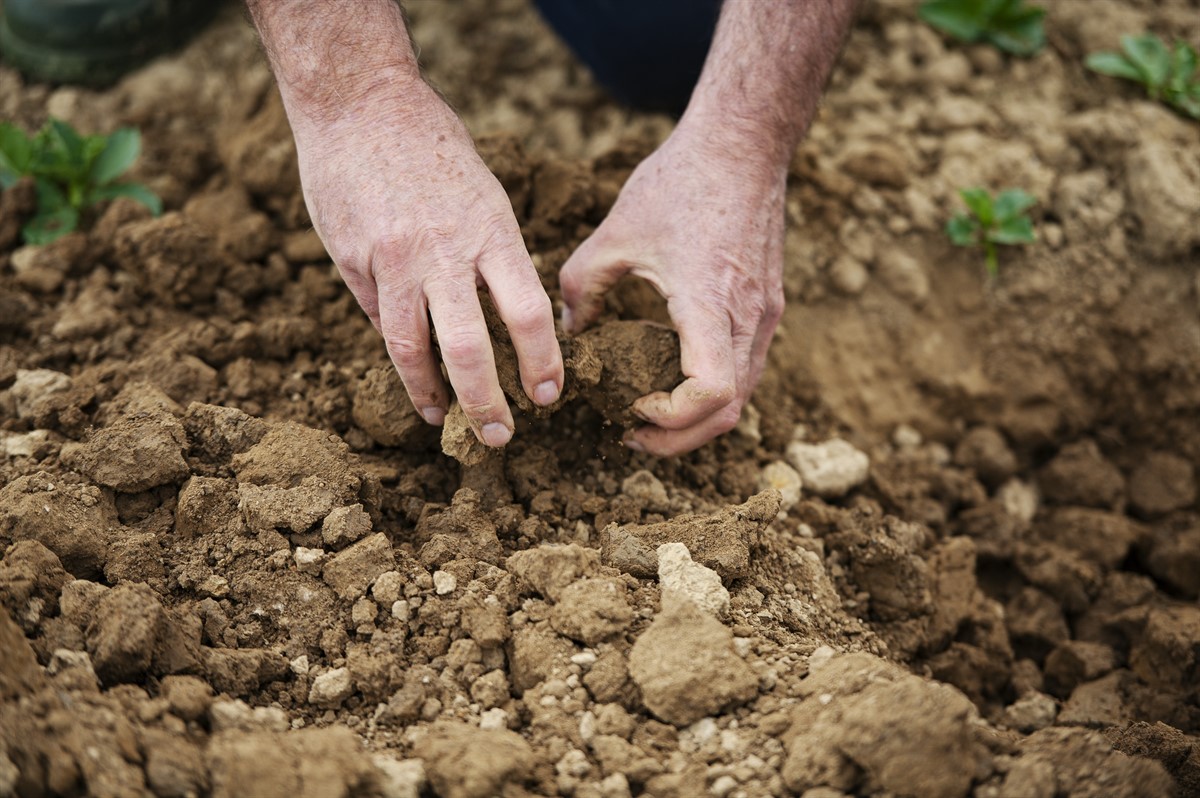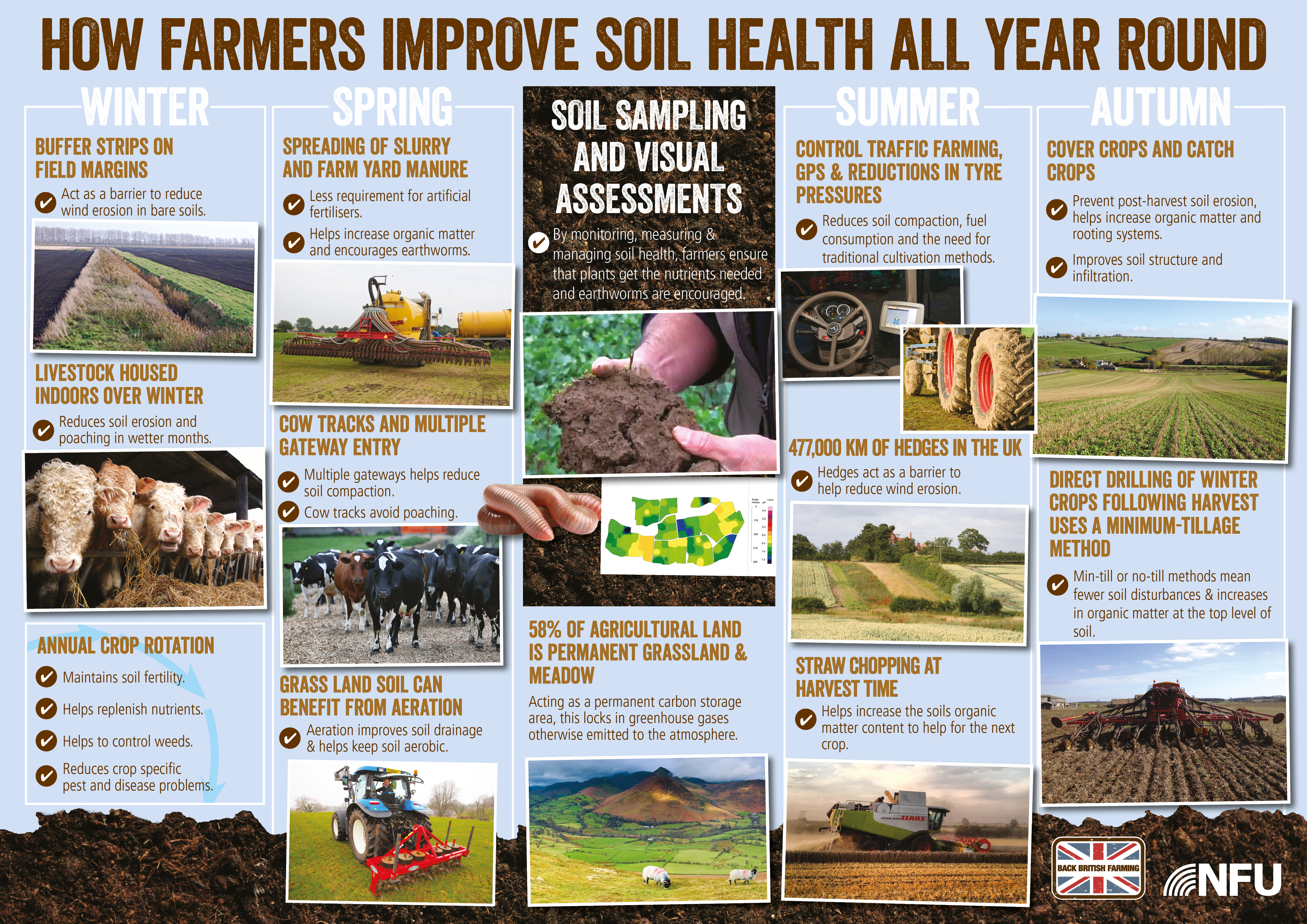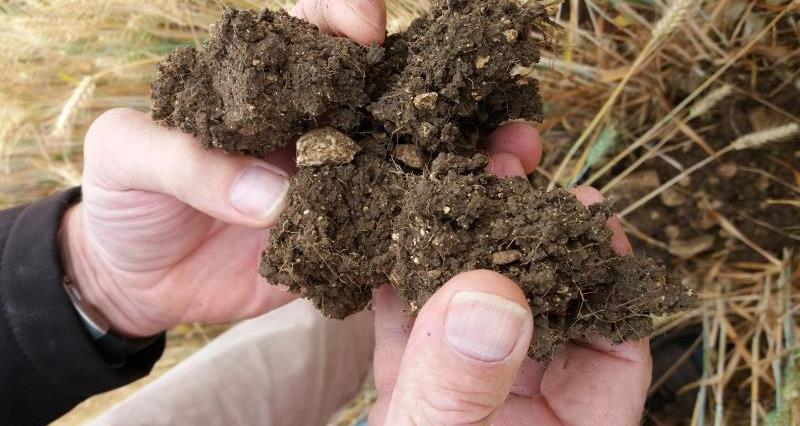Good soil health is crucial to our farming systems, providing the essential medium to grow our food and the foundation for our varied landscapes.
British farmers and growers are doing a great deal of proactive work to improve soil health, from routinely testing the soil's nutrient content to using drones to help understand soil structure.
To help you improve your soil, we've put together eight ways you can protect and enhance your soil while producing climate-friendly food.
Reviewing cultivation methods
![]()
Although not suitable for all soil types, direct drilling and minimum tillage are both increasing in popularity, driven by improvements in equipment.
Reducing cultivations lowers the cost of crop establishment through less machinery use, fuel and labour cost.
Aiming for better nutrient balance
Have an effective plan in place for nitrogen and phosphorus use and match applications to crop
requirements.
Routinely test soil and use the data to maintain or improve crop and livestock productivity, as well as environmental benefits.
Organic matter maintenance
Preserving organic matter through increased organic inputs and maintaining soil cover throughout the year.
Cover crops protect and enrich soil between periods of regular crop production.
Farmyard manures, alternative organic sources such as digestate, compost and biosolids can increase soil organic matter in arable soils.
Optimising crop rotations
Growing a diversity of crops in succession helps build up soil health and soil fertility, and can help combat pests, weeds and
diseases.
Grass leys in arable rotations can improve soil organic matter through grass root growth.
Agroforestry
![]()
Introducing more trees into a productive crop or livestock system could help restore degraded soil.
The right tree for the right place is fundamental to success and trees can also provide additional income as well as wildlife and conservation benefits.
Reducing compaction
![]()
Using controlled traffic farming (CTF) to limit all farm machinery to fixed tramlines across fields.
Machinery will drive on 25% to 40% of the field in a season, compared to 85% in a conventionally ploughed field.
Improved soil structure can lead to 15-30% increased yields.
Maintaining good drainage
![]() Good drainage is essential for healthy soil, productivity and resilience against climate change.
Good drainage is essential for healthy soil, productivity and resilience against climate change.
Avoiding waterlogging and compaction extends grazing seasons on grassland and improves the workability of arable land, promoting good crop establishment.
Peatland management
![]()
Tree shelter belts around fields and utilising cover crops can protect peat and high value vegetable crops.
There is also increasing adoption of practices such as subterranean irrigation, precision farming (which uses machinery guided by satellite technology), minimum till technology and no-till technology.
Reviewing cultivation methods
![]()
The cultivation of soil has changed over the years; different systems have developed as technology has advanced.
Ploughing
Ploughing is traditionally the primary method of cultivation, and it provides many positive aspects for soil structure – turning the soil, burying the remains of previous crops, releasing nutrients to plants, aerating the soil and controlling weeds – key roles in crop establishment in arable soils.
But cultivation releases the carbon stored to the atmosphere as CO21 and it can also have negative impacts on earthworms and other soil organisms, as well as increased energy costs.
As climate and weather patterns change, cultivation practices will change as well.
Direct drilling and minimum tillage
Although not suitable for all soil types or certain weather conditions, direct drilling and minimum tillage have both increased in popularity, driven by improvements in equipment although investment costs can be high.
Reduced cultivations
Reducing cultivations lowers costs of crop establishment in the long term through less machinery, fuel and labour costs.
However, there are challenges with reduced cultivations such as grass weeds, slugs and surface compaction and this practice is not appropriate for all soils. It is important that the right cultivation practice, introduced systematically over time, is adopted2.
Aiming for better nutrient balance
![]()
Nutrients are critical for crop growth and good yields. As organic matter decomposes the nutrients are incorporated into the soil and made available to plants.
Farmers and growers need to have effective plans in place for optimum nitrogen and phosphorus use3, and match applications to the growing crop requirements where possible.
Impact on the environment
Excessive use of inorganic or organic fertilisers can have a detrimental effect on the wider environment. Application of nitrogen and phosphorus in organic and inorganic fertilisers decreased between 2000 and 2020, with an estimated soil nutrient balance for nitrogen decreasing by 17% and phosphorus by 27%4,5.
Tried and Tested is an industry initiative to promote good nutrient management, and provides helpful tools and advice to farmers and growers about nutrient management planning.
Soil testing and metrics
Healthy soil has a good balance of physical, chemical and biological properties. Many farmers and growers already routinely test their soil and use the data to maintain or improve crop and livestock productivity, as well as environmental benefits.
But we need to see more farmers and growers testing their soils more frequently.
Testing soil should be accessible for farmers and growers, and it’s important to make sure that the soil test and the soil laboratory used are consistent to provide more accurate results.
Soil-health indicator
AHDB (Agriculture and Horticulture Development Board) is developing a soil-health indicator system akin to traffic lights and an MOT6 to guide farmers and growers as they check their land.
Using standardised soil sampling techniques to achieve a representative sample is key.
The use of location apps such as what3words7 can locate three metre by three metre squares within fields, giving sampling greater location accuracy.
Metrics for monitoring and measuring soil health
- Diseased leaves, weeds and areas of bare soil provide indicators to allow precision application.
- Leaf nitrogen analysis: Mobile apps can perform leaf nitrogen analysis to assess more accurately a crop’s requirements from the soil.
- Remote sensors collect soil data at varying landscape scales.
Visual assessments can be readily carried out by non-soil scientists and include the scale of friability or compaction, size of clods, root density, penetration resistance, bulk density, infiltration rates, earthworm counts.
Developing technology is allowing farmers and growers to use drones to pinpoint and manage larger data sets.
Most soil carbon offset companies are now using a hybrid measurement approach, from sample testing to digital mapping, remote sensing, satellite tracking and modelling. Baselines have become more sophisticated, tracking against how previous farming practices would have performed in current climate conditions to assess the difference achieved with new farming practices.
This dynamic baseline approach allows for natural fluctuations, so that if for example there was a drought, CO2 would be released, but less so than under the old farming practices.
Improving and maintaining organic matter
![]()
Cover crops are crops that are not harvested but are grown to protect and enrich soil between periods of regular crop production. They help add organic matter to the soil, reduce erosion and run-off caused if soil is left bare, increase soil biodiversity, conserve soil moisture and help protect water quality.
Between 2014 and 2015 the total area of cover crops, nitrogen fixing crops and fallow land increased by 45%, 29% and 19% respectively3. Cover crops are not suitable for every situation, for example their use can depend on soil type and rotation.
Role of organic manures
Farmyard manures and alternative organic sources such as digestate, compost and biosolids, can increase soil organic matter in arable soils, provide valuable sources of nutrients such as nitrogen, phosphorus, potassium, phosphate, sulphur and magnesium8, and improve soil structure.
Increasingly, farmers and growers are conscious of the importance of checking the nutrient contents of organic manures and testing soils to ensure these sources are suitable for and complement crop production. However there are limitations. Quantities required to achieve optimum nutrients may exceed regulatory application levels. Overall supply is finite and availability depends on location.
Optimising crop rotations
![]()
Crop rotations build up soil health and soil fertility, and are an important part of integrated pest management. Longer rotations with a variety of crops can help combat pests, weeds and diseases9, 10 and increase diversity in the farming landscape.
Mixtures of crops including cereals, oilseeds and higher nitrogen content crops like forage or grain legumes provide a diverse source of food for soil organisms which, in turn, recycle nutrients.
Inclusion of grassland in rotations
Including medium term (three to five year) grass leys in arable rotations can improve soil organic matter through grass root growth11.
Where systems can use livestock it can also help control grass weeds, like black grass, by preventing fresh seed shedding.
As with cover crops, introducing herbal leys with plants that root at different depths also helps soil structure and builds fertility12, with deeper roots helping to break up compacted soil.
Agroforestry
![]() Introducing more trees into the farming landscape could help restore degraded soil while allowing a productive growing system where trees and crops and/or livestock share the space.
Introducing more trees into the farming landscape could help restore degraded soil while allowing a productive growing system where trees and crops and/or livestock share the space.
As set out in the NFU’s Tree Strategy, choosing the right tree for the right place is fundamental to the success of trees in a farming landscape.
Trees can also provide additional income streams through fruit or nut crops and coppicing, as well as benefits such as more wildlife and water conservation.
Reducing compaction
![]() As the weight of machinery travelling across farmland has increased, so has compression of the soil structure leading to compaction. The implications are numerous:
As the weight of machinery travelling across farmland has increased, so has compression of the soil structure leading to compaction. The implications are numerous:
- poor plant root development
- restricted plant growth
- reduced nutrient recycling and lower yields
Livestock can also compress soils in wet conditions, leading to poorer water infiltration, nutrient losses and flooding.
Controlled traffic farming
Adopting practices like controlled traffic farming (CTF) reduces soil compaction by limiting all farm machinery to fixed tramlines across fields. This means that machinery will drive on 25% to 40% of the field during farming operations in one season using CTF, compared to 85% in a conventionally ploughed field14.
Improvements in soil structure due to CTF can lead to increased yields of between 15-30%, better nutrient uptake, reduced erosion and improved water infiltration so more water is available to crops and the risk of flooding is reduced.
Farmers practicing CTF have seen improvements in biology, a reduced need for deep cultivations and lower labour and fuel costs.
CTF can be used on any arable, grassland, mixed or horticultural farm. It works well with no-till or min-till farming15. In addition some farmers are using machinery with offset wheels to spread the load over a wider area.
Maintaining good drainage
![]() Good drainage is essential for healthy soil, productivity and resilience against climate change. It extends grazing seasons on grassland and improves the workability of arable land, promoting good crop establishment.
Good drainage is essential for healthy soil, productivity and resilience against climate change. It extends grazing seasons on grassland and improves the workability of arable land, promoting good crop establishment.
Poorly drained soils are slow to warm in the spring, increase weed burdens, and reduce the length of the growing season and compromise harvesting.
Effective drainage reduces waterlogging after periods of heavy rainfall, which prevents damage to the soil structure and greenhouse gas emissions of nitrous oxide. The increased infiltration reduces the likelihood of surface erosion and losses of nutrients and sediments to watercourses, as well as reducing the risk of compaction15.
Heavier soils benefit from well-functioning drainage systems, which in conjunction with good soil porosity and organic matter levels, can provide twin benefits of reduced flooding and increased water holding capacity.
Successful drainage, as part of integrated water management, brings multiple environmental benefits on top of boosting productivity.
Controlled drainage is a long-term and significant infrastructure commitment requiring investment, which can be an issue for tenant or contract farmers.
Riparian buffer strips provide environmental drainage helping prevent erosion, collect sedimentation and reduce nitrate run-off.
Peatland management
![]() Organic and peat soil make up 11% of England’s total land area. Only 13% of England’s peatlands are in a near natural state. However, modern farming systems are evolving to better manage peat and optimise the potential of varying grades and classes of soil, including silt and clay soils.
Organic and peat soil make up 11% of England’s total land area. Only 13% of England’s peatlands are in a near natural state. However, modern farming systems are evolving to better manage peat and optimise the potential of varying grades and classes of soil, including silt and clay soils.
To protect peat and high value vegetable crops, farmers and growers have planted tree shelter belts around fields and are utilising cover crops.
Conservation practices
There is also increasing adoption of peat conservation practices such as subterranean and trickle irrigation, precision farming (which uses machinery guided by satellite technology), minimum till technology, and no-till technology.
Lowland peat – The Fens
The Fens is the largest contiguous area of lowland peat in the UK – one of the most carbon-rich ecosystems in the country1. The Fens cover less than 4% of England’s farmed area but produce more than 7% of England’s total agricultural production. In the Fens, agricultural production is worth £1.23 billion and the whole food chain, from farm to fork, generates more than £3 billion a year for the economy. 80,000 people are employed across the whole food chain in the Fens. Loss of such areas would likely increase our reliance on imports.
Changing the management of agricultural peatlands
While Defra research has established that lowland peats in England and Wales are large sources of greenhouse gas emissions, it concludes that major emissions reductions appear achievable through changing the management of agricultural peatlands1. This could include reduced tillage,2 grass leys, cover cropping and water management, which could be introduced through ELMs SFI.
While the uplands may represent better opportunities for restoration, in order to ensure the long-term future of sustainable farming businesses delivering at reasonable cost, we are not convinced by the argument that ‘all blanket bog can be restored’.
The value of uplands farming, both economically and environmentally, must not be overlooked. The uplands contain 44% of England’s breeding ewes and 40% of England’s beef cows.



